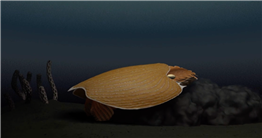
Some 506 million years ago, a predator swept over the silt bottoms of the Cambrian ocean. Its rake-like feeding arms sifted through the murk it raised, funneling soft-bodied worms into a puckering, circular mouth.
In 2018, a team of paleontologists from the Royal Ontario Museum discovered the preserved shell of that ancient hunter during a fossil hunting expedition in the Canadian Rockies. On Wednesday in the journal Royal Society Open Science, the team identified the 19-inch animal, which they named Titanokorys gainesi, as one of the earliest-known large predators on Earth.
“At a time when most animals were the size of your little finger, this would have been a very large predator and probably near the top of the food chain,” said Joe Moysiuk, a Ph.D. student at the University of Toronto and co-author of the study.
Titanokorys belonged to a time when the first recognizable ecosystems were taking shape. Over a half-billion years ago, the quiet gardens of the Ediacaran — largely full of soft-bodied organisms feeding on microbial mats — vanished. As the first predatory animals evolved, ecosystems grew more complex and many of the major animal groups that still live today appeared for the first time: a geological turnover called the “Cambrian explosion.”
In 1909, the first evidence of this change was uncovered by Charles Walcott, an American paleontologist, in the Burgess Shale of the Canadian Rockies. Researchers studying fine-grained sediments there found the soft-bodied imprints of a wild — if tiny — menagerie. Alongside early arthropods like trilobites and the earliest ancestors of vertebrates were Lovecraftian animals like Opabina and Halluciginia, resembling nothing known today.
The primary carnivores of this ecosystem were an extinct family of arthropods called radiodonts, named for their toothy, circular jaws. The largest and most iconic of the family, Anomalocaris, was a three-foot apex predator, with a streamlined body and fluttering paddles that helped it zip through open water.
For decades, Anomalocaris was the only large predator known from the Burgess Shale, said Jean-Bernard Caron, curator of invertebrate paleontology at the Royal Ontario Museum. But in 2014, as he and colleagues were collecting from a new quarry in Kootenay National Park in British Columbia, they began finding scraps of a mysterious new animal. Four years later, a complete carapace “the size of a football helmet” turned up.
“It was absolutely mind-boggling,” Dr. Caron said. “A fossil like that is very rare. It took some time for us to assemble the whole thing, but it allowed us to understand this animal for the first time — to show that there are other big predators in this community.”
Though related to Anomalocaris, Titanokorys was a different kind of hunter. While it shared the lobed swimming paddles of its larger relative, its broad head carapace — Mr. Moysiuk calls it “spaceship-shaped” — took up half its body length. It had jointed claws and rear-set, upward-facing eyes, suggesting it spent most of its time on the seafloor. It probably lived like a modern stingray or horseshoe crab, hoovering up prey from the silty bottom.
The find also suggests that Cambrian ecosystems were more complex than previously thought. The same quarry that produced Titanokorys also produced another radiodont, Cambroraster, a much smaller species with a differently shaped shell but similar claws.
“It was a bit of a surprise to find two predators exploiting the same seafloor community, but with different carapaces,” Dr. Caron said. But such a range of large predators in the Cambrian suggests that the seas had sufficient resources for multiple different species of predator to coexist.
Predation may also have been an important driver of biodiversity, as species began engaging in an evolutionary feedback loop between predator and prey. As prey developed stronger armor, predators countered with stronger jaws; both predator and prey needed better eyes. “The notion of an arms race in evolution is becoming increasingly important,” Mr. Moysiuk said, and early predators may have been vital to the development of the tangled, intricate ecosystems we know today.
The find also highlights how much left there is to learn about the Cambrian, Dr. Caron said. “Every time we move sites we find different species,” he said. “We’ve only scratched the surface of these mountains.”
Source: Read Full Article

